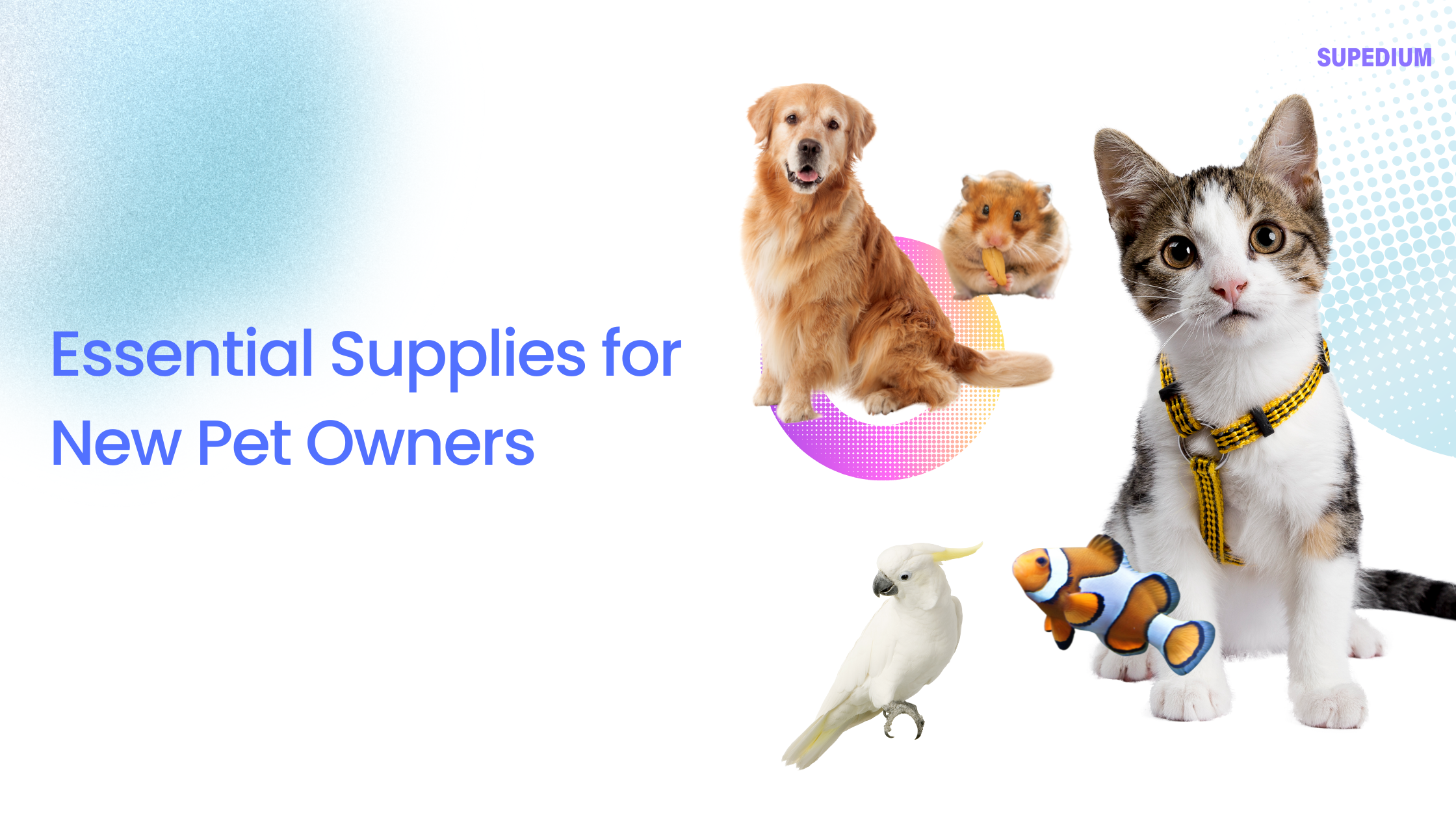Table of Contents
![]()
Welcoming a new pet into your home is an exciting and life-changing experience. To ensure a smooth transition and provide your furry, feathered, or scaly friend with the best possible start, it’s essential to be well-prepared with the right supplies. This guide will help new pet owners navigate the basics and beyond, ensuring your pet’s needs are met with ease and efficiency.
I. Introduction
Importance of Being Prepared
Proper preparation is key to a successful start with your new pet. Being equipped with the necessary supplies not only enhances your pet’s comfort and safety but also helps you manage the demands of pet ownership more effectively. A well-prepared environment eases the transition for your pet and allows you to focus on building a loving relationship.
Overview of the Essentials
Every pet requires certain basic supplies to thrive. While there are core items needed for all pets, specific needs vary based on the type of animal. This guide breaks down the essentials for dogs, cats, small animals, and birds, along with general health and safety supplies.
II. Basic Supplies for All Pets
A. Food and Water
- Food: Choosing the right food is fundamental to your pet’s health. The type of food—dry, wet, or a mix—depends on your pet’s dietary needs. Ensure you select high-quality food that meets their specific nutritional requirements, considering age, size, and any special dietary needs.
- Water: Adequate hydration is crucial. Invest in bowls or dispensers that are durable and easy to clean. Options include plastic, metal, and ceramic bowls. Ensure the water source is always clean and accessible.
B. Housing and Bedding
- Pet Beds: A comfortable bed is essential for your pet’s well-being. Select a bed that is appropriately sized for your pet and easy to clean. For pets with specific health needs, such as older animals, consider options like orthopedic beds.
- Crates and Kennels: Useful for travel and training, crates and kennels provide a safe space for your pet. Choose the right size and type to ensure comfort and safety during transportation.
C. Grooming Supplies
- Brushes and Combs: Regular grooming is important for your pet’s health. Select brushes and combs suited to your pet’s fur type. Options include de-shedding tools for shedding breeds and specific brushes for long or short coats.
- Nail Clippers: Keeping your pet’s nails trimmed is crucial for their comfort and health. Choose a clipper that suits your pet’s size and learn proper trimming techniques to avoid injury.
- Shampoo and Conditioner: Use pet-specific grooming products to ensure your pet’s skin and coat remain healthy. Avoid human shampoos, as they may irritate your pet’s skin.
III. For Dogs
A. Leashes and Collars
- Collars: Collars should be adjustable and comfortable. Ensure you include an ID tag with your pet’s name and your contact information. Consider breakaway collars for added safety.
- Leashes: Choose a leash that suits your walking style and training needs. Options include retractable leashes for more freedom or standard leashes for control. Ensure the leash is sturdy and the length is appropriate for your walking routine.
B. Training Supplies
- Training Pads: Useful for house training puppies or dogs with limited access to outdoor spaces. Look for absorbent pads that are easy to clean and dispose of.
- Training Treats and Toys: Positive reinforcement is key to effective training. Use treats and toys to reward good behavior and keep your dog engaged. Select treats that are healthy and toys that are durable.
C. Toys and Chews
- Durable Toys: For play and mental stimulation, choose toys that can withstand chewing and rough play. Rubber toys, ropes, and interactive toys are popular choices.
- Chew Toys: Essential for dental health and preventing boredom. Opt for toys that are appropriate for your dog’s size and chewing habits.
IV. For Cats
A. Litter Box Supplies
- Litter Boxes: Select a litter box that is the right size for your cat and easy to clean. Consider options with high sides to prevent spills or covered boxes for added privacy.
- Cat Litter: Choose litter that clumps well and controls odor. Options include clumping clay, crystal, or biodegradable litters. Test different types to find what works best for your cat.
B. Scratching Posts and Pads
- Scratching Posts: Vital for preventing furniture damage, scratching posts come in various styles and materials. Options include carpeted posts, sisal-wrapped posts, and multi-level structures.
- Scratching Pads: Provide additional scratching surfaces to satisfy your cat’s natural instincts. Wall-mounted or freestanding pads are effective in different areas of your home.
C. Cat Trees and Condos
- Multi-level Trees: These offer climbing opportunities and scratching surfaces, providing enrichment and exercise. Choose a tree with various levels and perches to cater to your cat’s climbing preferences.
- Condo Options: Cat condos offer hideaways and cozy spots for napping. Ensure the condo is stable and made from pet-safe materials.
V. For Small Animals (Hamsters, Gerbils, etc.)
A. Cages and Habitats
- Cage Types: Choose cages that provide adequate space and ventilation. Wire cages are common, but glass tanks or aquariums may also be suitable depending on the species.
- Bedding: Use safe, absorbent bedding to keep your small animal’s habitat clean and comfortable. Options include paper-based bedding, aspen shavings, or hay.
B. Exercise Wheels and Toys
- Exercise Wheels: Ensure the wheel is the right size and has a solid running surface to prevent injury. Avoid wheels with wire rungs that can catch tiny feet.
- Chew Toys: Essential for dental health and mental stimulation. Provide a variety of chew toys made from safe, non-toxic materials.
C. Feeding Accessories
- Food and Water Dispensers: Choose dispensers that are easy to clean and refill. Options include hanging water bottles or gravity-fed waterers, and dishes for food.
- Food Bowls: Select bowls that are appropriately sized and made from durable materials. Ensure they are easy to clean and won’t tip over.
VI. For Birds
A. Cages and Perches
- Cage Sizes and Types: Ensure the cage is spacious and provides proper ventilation. Bar spacing should be appropriate for the bird’s size to prevent escapes or injuries.
- Perches: Provide a variety of perches made from different materials to prevent foot problems and offer exercise. Consider natural branches for added variety.
B. Toys and Enrichment
- Bird Toys: Stimulate your bird’s mind with toys that encourage foraging and play. Options include chew toys, puzzle toys, and bells.
- Swings and Mirrors: These provide entertainment and exercise. Ensure swings are secure and mirrors are bird-safe to prevent frustration or aggression.
C. Feeding and Watering
- Food Bowls: Use bowls that are easy to clean and secure to prevent spills. Choose bowls that accommodate your bird’s size and dietary needs.
- Water Dispensers: Opt for water bottles or bowls that are easy to refill and clean. Ensure they are designed to prevent contamination and spills.
VII. Health and Safety Supplies
A. First Aid Kit
- Basic Items: A well-stocked first aid kit should include bandages, antiseptics, tweezers, and a thermometer. Include items specifically for pets, such as an eye wash or ear cleaning solution.
- Pet-Specific Items: Include a list of emergency contacts, your pet’s medical history, and any medications they are currently taking.
B. Identification and Microchipping
- ID Tags: Ensure your pet wears a collar with an ID tag that includes your contact information. This helps in the event your pet gets lost.
- Microchipping: A microchip provides a permanent form of identification that can help reunite you with your pet if they become lost. Ensure the chip is registered and up-to-date.
C. Cleaning Supplies
- Stain and Odor Removers: Use pet-safe cleaners to handle accidents and maintain a clean home environment. Avoid harsh chemicals that could harm your pet.
- General Cleaning Products: Choose non-toxic cleaning products that are safe for pets. Regular cleaning helps prevent the spread of germs and allergens.
VIII. Optional but Recommended Supplies
A. Pet Carriers
- Types: Choose carriers based on your needs—soft-sided carriers for easy travel or hard-sided carriers for secure transport. Ensure they are comfortable and well-ventilated.
- Travel Safety: Consider using harnesses or seat belts to secure your pet in the car. This ensures their safety and prevents distractions while driving.
B. Pet Insurance
- Coverage Types: Pet insurance can cover accidents, illnesses, and routine care. Review different plans to find one that fits your pet’s needs and your budget.
- Choosing a Plan: Consider factors such as coverage limits, deductibles, and exclusions. Select a plan that provides comprehensive coverage and peace of mind.
C. Pet Cameras
- Monitoring: Pet cameras allow you to keep an eye on your pet when you’re not at home. Look for features such as live streaming and motion detection.
- Interaction: Some pet cameras offer two-way audio and treat dispensers, allowing you to interact with your pet remotely and reward them for good behavior.
IX. Conclusion
Recap of Essential Supplies
Equipping yourself with the right supplies ensures that your new pet has a smooth transition into your home. From food and water to grooming tools and safety items, each supply plays a crucial role in maintaining your pet’s health and happiness.
Final Tips for New Pet Owners
Introduce new items gradually to help your pet adjust. Regularly assess and update your supplies as your pet grows and their needs change. With the right preparation, you’ll be well on your way to providing a loving and well-cared-for home for your new companion.
Share This





Be the first to comment